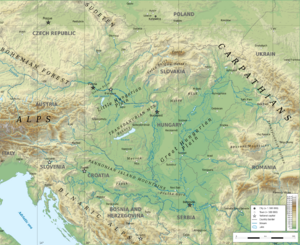Battle of Nedao facts for kids
Quick facts for kids Battle of Nedao |
|||||||
|---|---|---|---|---|---|---|---|
| Part of Germanic-Hunnic Wars | |||||||
 Topographic map of Carpathian Basin |
|||||||
|
|||||||
| Belligerents | |||||||
| Gepids Heruli Rugii Sciri Suebi |
Huns Alani |
||||||
| Commanders and leaders | |||||||
| Ardaric | Ellac † | ||||||
The Battle of Nedao was a very important fight that happened in 454 CE. It took place in a region called Pannonia, which is in modern-day Central Europe. This battle was fought between the Huns and several Germanic tribes who used to be under Hunnic rule. The exact location of Nedao is not known for sure, but some think it was near the Sava River.
Contents
The Battle Begins
After the powerful Hunnic leader Attila the Hun died, his sons started fighting among themselves for control. This created a chance for the tribes that the Huns had conquered to try and gain their freedom.
One of these leaders was Ardaric, the king of the Gepids. He brought together many different Germanic tribes. These included the Gepids, Heruli, Rugii, Sciri, and Suebi. They decided to challenge the Huns.
Attila's eldest son, Ellac, led the Hunnic forces. He was fighting his brothers, Ernak and Dengizich, for power. This internal conflict weakened the Huns before the big battle.
What Happened in the Battle
The historian Jordanes, who wrote in the 500s CE, described the battle. He said it was an amazing sight to see so many different groups fighting.
- The Goths fought with long spears.
- The Gepids used swords.
- The Rugii broke their spears in their enemies.
- The Suebi fought on foot.
- The Huns used bows and arrows.
- The Alani had heavily armored fighters.
- The Heruli were light, quick warriors.
After a tough fight, the Germanic tribes led by Ardaric won. Jordanes claimed that about 30,000 Huns and their allies were killed. Ellac, Attila's favorite son, also died in this battle.
Another old story, from a Hungarian book called Chronicon Pictum, tells a slightly different version. It talks about Attila's sons, Csaba and Aladar, fighting each other after their father's death. This account says the fighting was so fierce that the Danube River ran red with blood for many days. While this story is different from Jordanes', both show that Attila's empire fell apart due to internal fighting and strong resistance from other tribes.
Historians' Views Today
Historians today still discuss some details about the Battle of Nedao. For example, Jordanes wrote that the Ostrogoths fought against the Huns. However, some modern historians, like Herwig Wolfram and Hyun Jin Kim, disagree. They believe this part of the story might not be true. Hyun Jin Kim even thinks the Ostrogoth king Valamir might have fought with the Huns.
Other historians, like J.R. Martindale and Franz Altheim, agree that the Ostrogoths were among the winners. But some, like Otto J. Maenchen-Helfen, think the whole idea of the Ostrogoths being involved in that way is incorrect. These different views show how historians try to piece together events from long ago using old texts, and sometimes they come to different conclusions.
What Happened After the Battle
The Battle of Nedao was a huge turning point. It broke the power of the Huns in Central and Eastern Europe. The Hunnic Empire, which had been so strong under Attila, completely fell apart by the early 460s.
The Germanic tribes who won the battle, like the Gepids, Rugii, Heruli, Suebi, and Ostrogoths, became independent. Many of them later made agreements with the Eastern Roman Empire.
The remaining Huns, led by Attila's son Dengizich, moved eastward. They tried to attack the Eastern Roman Empire again in 469 CE but were defeated for good. After this final loss, the Huns disappeared from European history. The Battle of Nedao marked the end of their great empire.
See also
- The Battle of the Goths and Huns
Sources
- Herwig Wolfram. History of the Goths, transl. Thomas J. Dunlap., University of California Press, 1990, ISBN: 0-520-06983-8.

